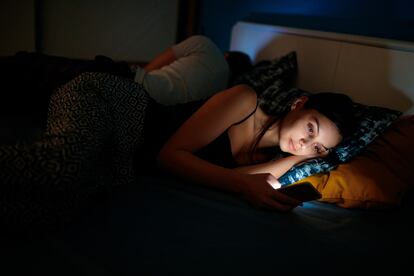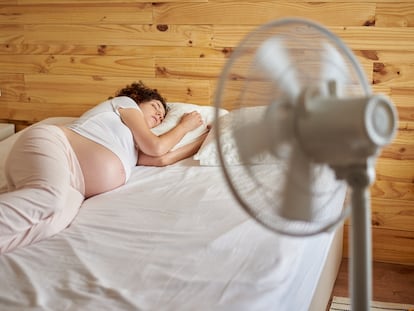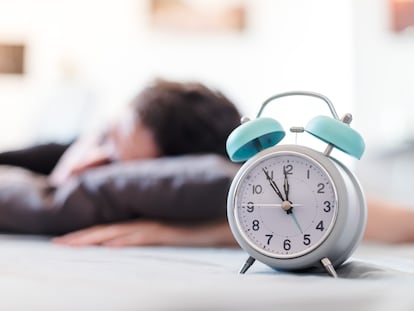Red light for sleep: How effective is this remedy that promises a restful sleep?
Getting a good night’s sleep is a pipe dream for many people. This explains the surge of products that promise to end our insomnia. We spoke with experts about their effectiveness

Getting a good night’s sleep is nearly impossible for the vast majority of the population. This explains the consolidation of the sleep business, an expanding sector where you can find everything from coaches specializing in sleep therapies, to psychologists who are experts in sleep disorders, and all types of devices focused on improving rest, like white noise machines. And we cannot forget the natural remedies, with a special mention for melatonin. In this scenario, it is worth noting the growing popularity of red light as an antidote to lack of sleep. The theory is simple: changing traditional lighting for a reddish light in the instants before going to bed could promote rest. But does it really work in practice?
“The body needs a physiological sunset, and in the society in which we live, it is very difficult due to the external stimuli we receive, both in terms of physical activity and mental activity, and lighting, so we have to try to work on that. To achieve this physiological sunset, red lights are becoming popular,” explains Dr. Àlex Ferré, a specialist in sleep medicine.
Ferré specifies that the lights do not necessarily have to be red, but “from the light spectrum outside 480 nanometers, which is green and blue light, which inhibits melatonin. The rest of the light spectrum, yellow, red and orange, which is like the light of fire, does not interfere with the melatonin rhythm.” Eduard Estivill, a doctor at the Estivill Sleep Clinic in Barcelona, speaks in similar terms, describing “the light of twilight” as an option to favor “the production of melatonin. When the brain receives this type of light, it begins to give orders to the pineal gland, which is responsible for producing melatonin.”
Therefore, maintaining warm lighting might be enough. According to the experts, there would be no difference if people used the reddish bulbs that can be purchased in many online stores, as long as they have yellowish or orange lights. For Estivill, the ideal thing would be to introduce this warm lighting starting at 7 p.m. (depending on the time we go to bed), since “melatonin, after two hours of being secreted, is an indicator of the biological clock and sends information to the suprachiasmatic nucleus of the hypothalamus so that sleepiness begins to appear,” he explains.
In addition to recommending ending any sports activity two or three hours before going to bed, Ferré advises avoiding any type of light once we go to sleep: “Sleep has to be in complete darkness, the least light from the outside, the better. If there is any light coming in or there is an alarm clock, it better have low-intensity red, yellow or orange lights.”
Avoiding any kind of light favors the production of melatonin, a hormone that, according to Dr. Guillermo Rodríguez, a doctor specialized in sports medicine, is strongly influenced by exposure to light. “When we are exposed to light, especially blue light, such as cell phones or computer screens, the production of melatonin is reduced, keeping us awake. On the other hand, in dark conditions, melatonin production increases, preparing the body for sleep,” he explains. Furthermore, Rodríguez points out another peculiarity of red light when it comes to producing “a relaxing effect on the brain, helping to reduce stress and anxiety, which in turn facilitates sleep.”

The red light that is proposed as a possible solution to poor sleep should not be confused with the red light used for muscle recovery, a therapy that has attracted the attention of the specialized press in recent years as it is linked to many elite athletes. Dr. Guillermo Rodríguez emphasizes that this therapy is not new, but it has been modernized recently thanks to the evolution of the devices with which it is put into practice. Unlike the red light used for sleeping, in this case it is not simple points of light, but infrared light: “The emission of infrared irradiation (wavelength between 600 and 950 nanometers) produces heat that penetrates the skin to depths of between 2 to 10 millimeters. It produces a thermal effect that can provide some benefits for the recovery of muscle injuries,” he points out. Andrés Mundilla, a physiotherapist, states that these types of techniques are becoming more popular among professional or semi-professional athletes because they are those for whom recovery plays a more important role in their daily life. “However, its use is becoming more and more popular among amateur athletes,” he notes.
Going to bed with your phone in your hand
The applications of red light are varied and, although its use for sleeping does not convince everyone, it does not have the terrible reputation of blue light from screens. A lot of people report going online or using social media right before going to bed, a habit that has a negative and direct impact on rest.
“We know that excessive blue light can cause damage to the retina. In addition, there is a part of blue light that directly influences the circadian cycle that controls the times in which we are awake or sleepy,” explains Fabio Delgado, an optician and optometrist. Being exposed to blue light from screens for a long time works against us, which is why some cell phones have incorporated “night mode,” changing the screen to red, which in theory is more beneficial for falling asleep. For example, the Night Shift mode on iPhones adjusts the color temperature to achieve warm lighting. With the aim of minimizing damage from blue light during everyday life, glasses with specific lenses have also proliferated that “either by having a treatment on their surface or incorporated into the mass of the lens, they reduce the amount of blue light that passes through the lens,” Delgado explains.

However, as with the red light, there is no consensus on its full effectiveness. A recent report by Spain’s consumer organization OCU in partnership with the independent platform Cochrane Collaboration questioned the usefulness of these glasses and their use to improve sleep quality. According to the publication, six trials were analyzed and “inconsistent results” were obtained: three studies showed that there were hardly any differences between wearing glasses with a filter and wearing glasses without a filter, while three other trials did show an improvement in the subjective quality of sleep (degree of certainty of the evidence: very low). It looks like, for the moment, there is no magic solution that will guarantee a restful sleep.
Sign up for our weekly newsletter to get more English-language news coverage from EL PAÍS USA Edition
Tu suscripción se está usando en otro dispositivo
¿Quieres añadir otro usuario a tu suscripción?
Si continúas leyendo en este dispositivo, no se podrá leer en el otro.
FlechaTu suscripción se está usando en otro dispositivo y solo puedes acceder a EL PAÍS desde un dispositivo a la vez.
Si quieres compartir tu cuenta, cambia tu suscripción a la modalidad Premium, así podrás añadir otro usuario. Cada uno accederá con su propia cuenta de email, lo que os permitirá personalizar vuestra experiencia en EL PAÍS.
¿Tienes una suscripción de empresa? Accede aquí para contratar más cuentas.
En el caso de no saber quién está usando tu cuenta, te recomendamos cambiar tu contraseña aquí.
Si decides continuar compartiendo tu cuenta, este mensaje se mostrará en tu dispositivo y en el de la otra persona que está usando tu cuenta de forma indefinida, afectando a tu experiencia de lectura. Puedes consultar aquí los términos y condiciones de la suscripción digital.
More information
Archived In
Últimas noticias
From Christmas movies to carols: Trump administration uses the holidays to push its anti-immigrant agenda
Trump’s worldview clashes with a Europe trying to defend itself
The program that guarantees Denver migrants will end up on the ‘Success Wall’
Venezuelan oil, the ultimate prize coveted by the United States
Most viewed
- Christian Louboutin: ‘Young people don’t want to be like their parents. And if their parents wear sneakers, they’re going to look for something else’
- ‘El Limones’ and the growing union disguise of Mexican organized crime
- The low-cost creative revolution: How technology is making art accessible to everyone
- ‘We are dying’: Cuba sinks into a health crisis amid medicine shortages and misdiagnosis
- Cartels in Mexico take a leap forward with narco-drones: ‘It is criminal groups that are leading the innovation race’











































